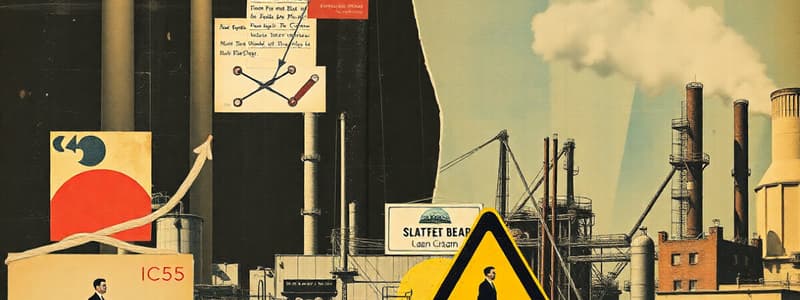Podcast
Questions and Answers
Safety ______ systems are important for managing risks in the workplace.
Safety ______ systems are important for managing risks in the workplace.
inventory
The ______ tree analysis is used to evaluate potential faults in a system.
The ______ tree analysis is used to evaluate potential faults in a system.
fault
Job safety ______ is a technique used to identify and mitigate risks associated with specific tasks.
Job safety ______ is a technique used to identify and mitigate risks associated with specific tasks.
analysis
Emergency preparedness includes creating ______ plans to effectively respond to crises.
Emergency preparedness includes creating ______ plans to effectively respond to crises.
The ______ Management System is aligned with international safety standards for process safety.
The ______ Management System is aligned with international safety standards for process safety.
Flashcards
Major Accident Hazard
Major Accident Hazard
A potential event with serious consequences, like an explosion or release of hazardous substances, that could severely impact people, property, and the environment.
Risk Assessment
Risk Assessment
The process of identifying hazards, analyzing their potential risks, and determining how likely they are to occur.
Hazard Analysis Techniques
Hazard Analysis Techniques
Methods to identify potential hazards, like fault tree analysis, failure mode and effects analysis (FMEA), and HAZOP.
Permit to Work System
Permit to Work System
Signup and view all the flashcards
Emergency Preparedness
Emergency Preparedness
Signup and view all the flashcards
Study Notes
Plant and Equipment Safety
- Plant safety appraisal and control techniques focus on observing, inspecting, and sampling plant safety to identify hazards, analyze jobs, manage safety inventory, ensure product safety, utilize permit-to-work systems, safety tag systems, and control losses and damage.
- Safety surveys and job safety analysis are critical tools in this process, aiming to identify potential hazards and develop corrective actions.
Laws and Regulations
- Key regulations include the Manufacture, Storage, and Import of Hazardous Chemicals (Amendment) Rules of 2000, Chemical Accidents (Emergency Preparedness, Planning, and Response) Rules of 1986, and Hazardous Waste (Management, Handling, and Transboundary Movement) Rules of 2008. These rules govern the handling and management of hazardous materials.
Hazards and Risks
- Hazard identification techniques include inductive, deductive approaches, Failure Mode and Effects Analysis (FMEA), and Cause Mapping Analysis (CMA).
- Fault tree analysis is used to understand the contributing factors in hazards and risks.
- Risk assessment techniques are crucial to evaluate the potential harm associated with identified hazards.
- Accurate accident investigation reporting and analysis are key to learning from past events and controlling performances.
Major Accident Hazard Control
- Understanding the concept, evaluation, and consequences of major accident hazards is vital. Hazard analysis techniques allow for the measurement and control of these events.
- Management, local authorities, and the public play roles in preventing and responding to major accident hazards.
- Detailed onsite and offsite emergency planning, often with case studies, is crucial for preparedness and response.
- Effective control procedures and systems are essential for managing major hazards.
Importance of Disaster Management
- Disaster management concepts emphasize emergency preparedness at the local level.
- Contingency plans and emergency planning based on international standards like ISO 14001, OHSAS 18001, and OSHA's Process Safety Management System are important.
Studying That Suits You
Use AI to generate personalized quizzes and flashcards to suit your learning preferences.




